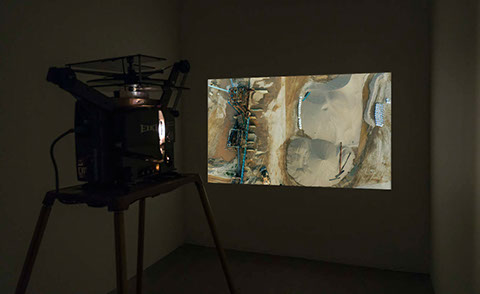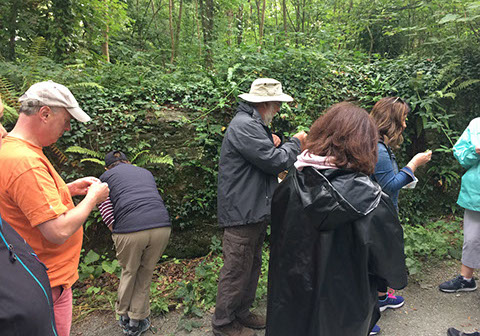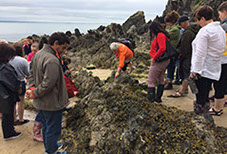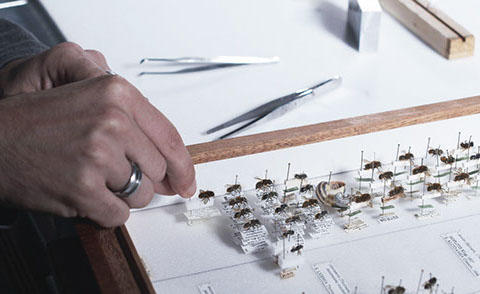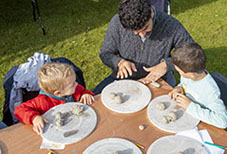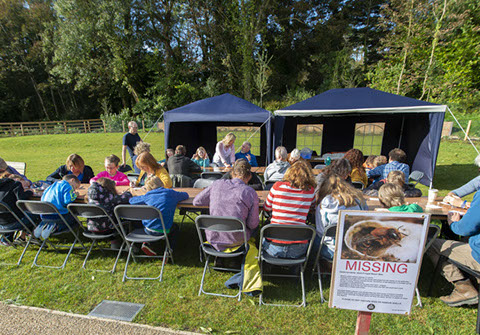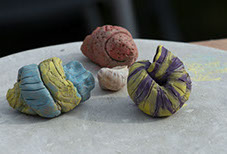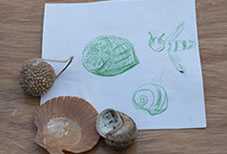An Urgent Enquiry Wexford: Mark Clare
Mark Clare explored the effects of climate change and habitat loss on local biodiversity in Wexford through engagement with the Biodiversity and Environment Departments in Wexford County Council, environmental specialists, scientists and local communities. His residency commenced with a series of workshops, interventions and public engagements. He coordinated a wild food walk in the grounds of Tintern Abbey led by Dermot Hughes of Forage Ireland; a seaweed forage on Baginbun Beach with The Sea Gardener Marie Power and ‘The Little Things Matter’ a workshop facilitated by Phycologist Lorraine Archer highlighting the important role of Phytoplankton (microscopic sea plants) on our ecosystems.
During his residency Mark designed ‘Missing’ posters and worked closely with the Environmental Department of Wexford County Council on the installation of the posters along fifteen blue flag beaches in Wexford, which highlighted the solitary bee, Osmia Aurulenta, a species of solitary bee found along the East coast that lives on sand dunes and nests in empty snail shells. These posters remained in situ on the fifteen beaches for over a year and drew a lot of public attention. Solitary bees pollinate more flowers than any other group of pollinators and are essential for the health of ecosystems. Motivated by a United Nations report on species extinction that highlighted up to one million plant and animal species are at risk of extinction within decades, Mark presented ‘The Missing’ workshops at Johnstown Castle which coincided with the inaugural Honey Festival in 2019. Adults and children were invited to produce ceramic snail shells with ceramic artist Máiréad Stafford. Participants donated one of the shells they produced to become part of The Unavoidable Interconnectedness of Everything, an ongoing art project that will attempt to engage people of all ages to produce 1,000,000 individual, handmade ceramic shells, each one representing an endangered species highlighted by the UN report. Together they will form a large-scale artwork in response to the report findings.
Mark also produced two video works Near Threatened and Inquiline which reflect on the solitary bee, Osmia aurulenta and Ballyteige Burrow in Wexford, a designated Special Area of Conservation (SAC). Further research on Osmia aurulenta with Dr. Aidan O’Hanlon, Curator of Entomology at the Natural History Museum, revealed the species requires monitoring as it is considered ‘Near Threatened’ in Ireland and at potential risk of extinction. They are dependent on their habitat and climate indicators as they respond to temperature increases which prompt them to emerge from hibernation. If they emerge too soon their survival is at risk as there food source will be limited. Dr. Aidan O’ Hanlon features in the video pinning a specimen of this solitary bee collected from Ballyteige Burrow. The video will become part of an installation comprising of a slide projection documenting the construction of Osmia aurulenta nests and will be accompanied by a sound recording featuring a narrator describing the nesting habits of this coastal bee.
Ballyteige Burrow in Wexford is one of the finest sand dune systems in South East Ireland and is home to a variety of rare species of flora and fauna. Mark worked closely with the Environment Department of Wexford County Council to capture drone footage of Ballyteige Burrow which was used in the production of the film Inquiline, a 16mm film presented using a projector. Each time the film runs through the projector it is slighted degraded through wear and tear and will over time completely degrade, reflecting the fragility of Ballyteige Burrow ecosystems. Both these video works highlight the important role of insects on local biodiversity, the interconnectedness and vulnerability of our natural environment.
The Missing, The Unavoidable Interconnectedness of Everything, Near Threatened and Inquiline were created by Mark Clare as part of An Urgent Enquiry residency commission for Wexford. Near Threatened and Inquiline will be presented to the public at a future date to be confirmed.
